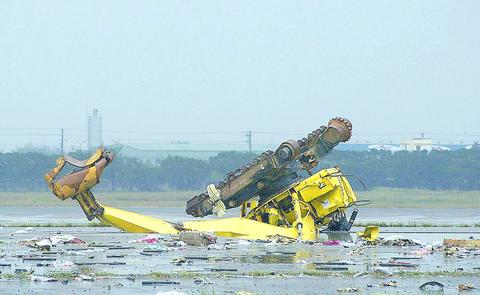Early inquiries into the crash of Singapore Airlines flight SQ006 suggest that the plane may have taken off from a runway that had been closed for repairs.
According to the nation's Aviation Safety Council (ASC,

PHOTO: TONY K. YAO
Runway 5R is parallel to runway 5L, from which the plane was supposed to take off.
"Initial facts are that the plane's wreckage and debris are mostly scattered on the 5R runway, and we don't rule out any possibilities, including the pilot may have mistakenly attempted to take off from the wrong runway," said Kay Yong (
Still, Yong was unwilling to conclusively say what caused the crash, which killed 81 people.
Investigators yesterdayv completed examination of the flight's data and cockpit voice recorders. They also continued to take ground surveys and aerial photos.
"We need to gather more information from interviews with the flight's crew members and pilots, as well as flight dispatchers," Yong said. "In addition, we still need time to sort out the sequence of events in the incident using more complete information ... We are still putting things together."
Yong said investigators would provide a more complete factual picture this evening to "help clear up rumors."
The Liberty Times reported yesterday that pilots on two China Airlines (
The CAL pilots saw the plane explode immediately upon takeoff, the report said.
But aviation council officials were unwilling to comment on the report.
Singapore Airlines, however, has ruled out the theory that the plane took off from the wrong runway.
Another theory investigators have been pursuing is that strong winds had caused the plane to veer off the 5L runway onto the closed one, which would have left tire marks in the 100m wide patch of grass separating the two.
But a mark found on the grass definitely did not belong to the ill-fated jet, aviation officials said. The mark, they said, resulted from a minor accident involving a Mandarin Airlines (華信航空) plane a little earlier in the day.
Yong also noted that the council has received "conflicting opinions on whether the lights alongside the 5R runway, where some construction was going on, were lit up."
If the lights were on, the pilot may have believed the 5R runway was open.
"These lights play an important role in aviation safety," Yong said.
The council also said that some lights along the 5L runway were damaged because of the minor accident involving Mandarin Airlines.
The council reconfirmed yesterday that visibility on Tuesday night's crash was greater than the minimum requirement of 200m.
The council will also examine whether the pilot had been given accurate meteorological information. Though a typhoon was approaching Taiwan on the night of the disaster, wind speeds recorded at the time were within acceptable limits.
Yong said aviation experts from the US, including members of the Federal Aviation Administration and National Transportation Safety Board, had planned to meet last night to clear up key points in the investigation.
"Pratt and Whitney, the manufacturer of the jetliner's engine, the Boeing company and a Singapore team will also join our meeting," Yong said.
Yong said representatives of National Transportation Safety Board of Australia would also be acting as observers during the full course of the investigation of the accident.

The US government has signed defense cooperation agreements with Japan and the Philippines to boost the deterrence capabilities of countries in the first island chain, a report by the National Security Bureau (NSB) showed. The main countries on the first island chain include the two nations and Taiwan. The bureau is to present the report at a meeting of the legislature’s Foreign Affairs and National Defense Committee tomorrow. The US military has deployed Typhon missile systems to Japan’s Yamaguchi Prefecture and Zambales province in the Philippines during their joint military exercises. It has also installed NMESIS anti-ship systems in Japan’s Okinawa

‘WIN-WIN’: The Philippines, and central and eastern European countries are important potential drone cooperation partners, Minister of Foreign Affairs Lin Chia-lung said Minister of Foreign Affairs Lin Chia-lung (林佳龍) in an interview published yesterday confirmed that there are joint ventures between Taiwan and Poland in the drone industry. Lin made the remark in an exclusive interview with the Chinese-language Liberty Times (the Taipei Times’ sister paper). The government-backed Taiwan Excellence Drone International Business Opportunities Alliance and the Polish Chamber of Unmanned Systems on Wednesday last week signed a memorandum of understanding in Poland to develop a “non-China” supply chain for drones and work together on key technologies. Asked if Taiwan prioritized Poland among central and eastern European countries in drone collaboration, Lin

NO CONFIDENCE MOTION? The premier said that being toppled by the legislature for defending the Constitution would be a democratic badge of honor for him Premier Cho Jung-tai (卓榮泰) yesterday announced that the Cabinet would not countersign the amendments to the local revenue-sharing law passed by the Legislative Yuan last month. Cho said the decision not to countersign the amendments to the Act Governing the Allocation of Government Revenues and Expenditures (財政收支劃分法) was made in accordance with the Constitution. “The decision aims to safeguard our Constitution,” he said. The Constitution stipulates the president shall, in accordance with law, promulgate laws and issue mandates with the countersignature of the head of the Executive Yuan, or with the countersignatures of both the head of the Executive Yuan and ministers or

CABINET APPROVAL: People seeking assisted reproduction must be assessed to determine whether they would be adequate parents, the planned changes say Proposed amendments to the Assisted Reproduction Act (人工生殖法) advanced yesterday by the Executive Yuan would grant married lesbian couples and single women access to legal assisted reproductive services. The proposed revisions are “based on the fundamental principle of respecting women’s reproductive autonomy,” Cabinet spokesperson Michelle Lee (李慧芝) quoted Vice Premier Cheng Li-chiun (鄭麗君), who presided over a Cabinet meeting earlier yesterday, as saying at the briefing. The draft amendment would be submitted to the legislature for review. The Ministry of Health and Welfare, which proposed the amendments, said that experts on children’s rights, gender equality, law and medicine attended cross-disciplinary meetings, adding that